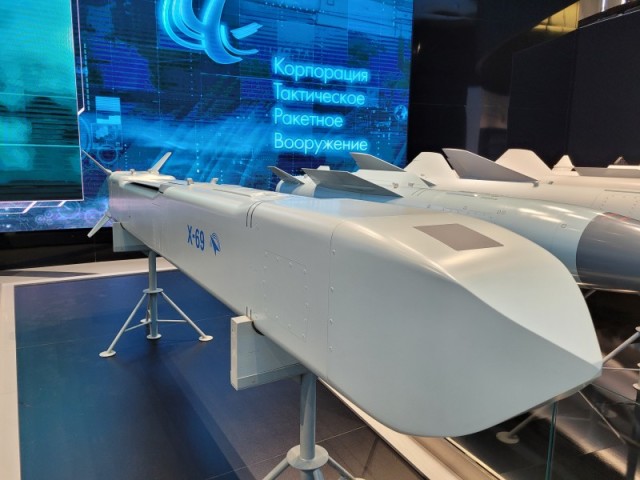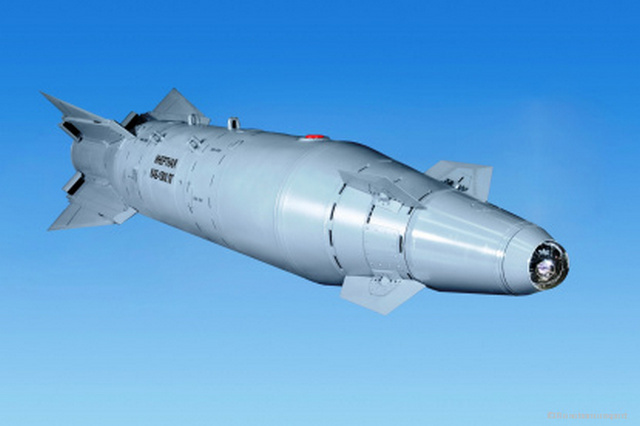What a weird looking precursor charge(s). I think the idea is these charges, which are canted inwards and focused on one point, would go off in quick succession and dig a much deeper channel. Seems to me the entire thing is set on a movable base as well so on oblique impacts the crosspiece moves the entire thing closer to normal to the surface and minimizing the impact of sloping.
It seems that they are shaped charges... but canting them inwards would not make sense as none of them would make a hole big enough for the entire missile to travel through.
I rather suspect they are angled slightly outwards and their purpose is to all go off together... imagine a sheet of glass... if you run into it it will stop many soft things not going particularly fast, but if you whip out a shotgun with four heavy ball bearing rounds in it and fire it just before you hit the glass the four spaced hits would shatter the glass so you would not be stopped by the glass as a solid wall... the four charges would shatter or at least seriously weaken the wall and then allow the HE warhead behind which is likely AP to penetrate through the hard outer shell and explode inside.
GPS guided so for fixed bunkers or heavy structures like dams or nuclear power stations perhaps?
Due to low volume of production in France as compared to greater numbers of similar weapons like JDAM built in the US.
TOR was designed to shoot down unpowered munitions like this and is ideal and very effective at the job.
S-350 would likely also be very good as would the new Pine system and of course Pantsir.... S-350 could probably shoot down the launch platform too with a 150km range and a 30km ceiling.
What different warheads? HAMMER can also be used against both ground based and sea based targets.
Often anti ship weapons have incendiary material added to them to make fires much more vigorous and dangerous... ironically surrounded by water a fire can often do more damage than the warhead exploding.
HAMMER has a range of over 60km at high altitudes and 15km at low altitudes. It has fire and forget capability, and an extended stand-off capacity.
15km is the range of the TOR system, while Pantsir can reach 20km in the current models and 40km in the new models, and the upgraded Pine will reach 20km too. High altitude release of a bomb would only work against a third world country because S-350 can reach 150km and BUK and of course the S-400 missiles can reach much further... flying at high altitudes would not be safe.
One of the only advantages NATO has in terms of missile design is stealthiness.
Even with advantages in stealth they will still struggle to penetrate Russian air defences. Western air defences on the other hand are worse than Soviet air defences in the 1980s and have nothing like the numbers the Soviets had then let alone the Russians have now.
Cruise missiles are already small, so if they are LO shaped and coated with RAM, they have extremely small radar signatures, and in a peer to peer environment when Radars are degraded due to jamming, this would make them almost impossible to detect
Not sure I agree... Russia is rather well covered by radar and also other EO systems these days, individual systems used separately and located near targets without an IADS in Syria operated by Syrians managed to shoot down most of the incoming American super missiles...
Amazing western air defences as shown by Saudi Arabia didn't even see drones and cruise missiles coming...
meanwhile russian missiles still arent LO, and many still use the retarded shitty engine pod, like the Kh-59, Kh-101 or Kh-55.
With low flying missiles an engine pod hanging under the weapon is not going to be visible to enemy aircraft and AWACS so it simply frees up more internal space for extra fuel.
Improvements in fuel and engine efficiency means they can be launched from ranges that are going to be safe from enemy responses.
This is still an extremely serious advantage, and it makes me think Russians are actually technologically primitive in designing Stealthy weapons and jet engines for cruise missiles, since they make them podded or with huge 80s tier intakes like with the Kh-35.
Actually I would say the opposite... the simple and cheaper construction costs means they can make orders of magnitude more missiles... likely more attack missiles than HATO has SAMs and AAMs creating the obvious problem for HATO... do you use up all your available defence missiles on their first and second and third wave of attack missiles, or do you save them for the wave of aircraft coming with the next batch of missiles?
The US is squealing about a new generation cheap cruise missile because they recognise the value of launching a lot of weapons at once... like the Russians currently can.
Compare the kh-35U intake to the JASSM. The JASSM is light years ahead.
Compare the quality of air defences each has to penetrate... the JASSM hasn't been able to get through since S-300... the Kh-35 will use up how many SAMs that they wont have an enormous number of? But who cares because you are comparing Americas best with something that entered service in the mid 1980s on ships made for East Germany... what about JASSM vs Zircon?
The taurus KEPD is in service since 2005 and has superior range, stealth and speed compared to the Kh-59 or Kh-69.
And the chances of it getting through are low.
I notice there not much talk about an old joint missile programme... seem to remember it was called ANS or something... French and German I believe... was going to use combined rocket and ramjet propulsion and for tactical fighters have a speed of mach 2.5, and be 800kgs and have a range of about 90km.
They talked about it for years.... with the 600kg mach 3 150km range Kh-31 never mentioned at all in any of the articles in western publications discussing the issue, but no, you tell me all about the superior western missiles...
Many russian Guided A/G weapons have the avdantage of being faster, but for the Kh-59, Kh-35, Kh-38, Drel, grom, LMUR are both slow and relatively easy to detect using Xband and OTH radar.
And what unified integrated air defence and OTH radar does HATO share at the moment?
Detection is just half the problem... besides you mentioned western stealthy weapons getting through because of jamming... are the Russians not allowed to use tactics to get their missiles through too?
And lets talk numbers... how many of those expensive western missiles have they got and how many cheap simple missiles can Russia make?
Also NATO 4th gen fighters(typhoon, EF-18, rafale, F-15E, F-16V, Tornado, Gripen can carry taurus KEPD, JASSM ER, SCALP, Storm Shadow, kongsberg NSM, and super hornets can carry LRASM and SLAM ER) can launch cruise missiles with 500km + range, while russian fighters and even Su-34s are limited to Kh-35s and Kh-59, and only russian heavy bombers can carry cruise missiles with equivalent range.
The HATO forces have nothing like Kh-32 or Kinzhal or the Tu-22M3M, and also more importantly nothing like TOR and Pantsir and S-400 and S-300 defending their forces.
Now Muricans withdrew their toys, as damage to its image was unstoppable.
Do you really consider, it would work any better against modern Russian PGMs?
Look at the difference... Iran attacked US forces in Iraq with ballistic missiles giving prior warning... and the US withdrew its SAM batteries in response????
In Syria the enemy are using drones and are likely getting support from the west, so Russia moves in more air defence systems and they seem to be very effective.
Sounds rather strange doens't it... almost like US air defence systems have not needed to work for so long they haven't bothered making them effective any more.
NATO doesn't have any land based IADS worth a damn that could take advantage of the exposed podded engines. The engines are on the bottom because during low level flight its hidden from any look-down radars mounted on surveillance or interceptor aircraft.
Stealth is not just a matter of designing stuff; its how you operate said stuff that has more bearing whether you are actually stealthed from the enemy.
And being sensible about the design making it cheaper they can make them in larger numbers and be less afraid to use them because replacements can be made easily and cheaply enough.




 ALAMO
ALAMO




